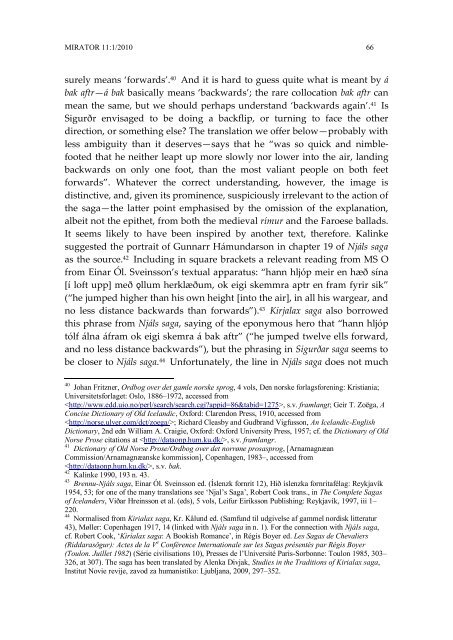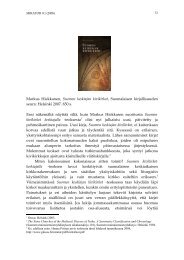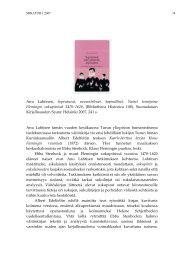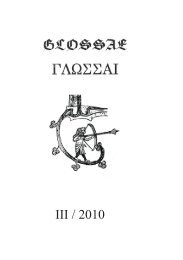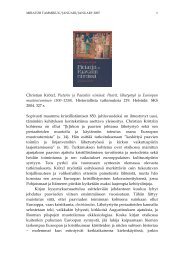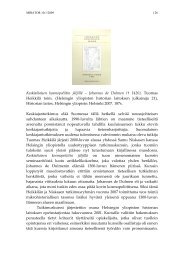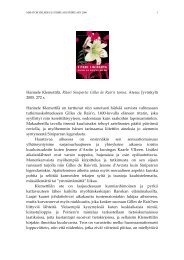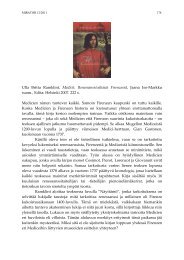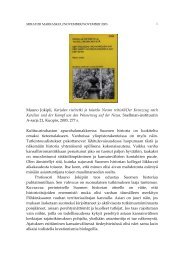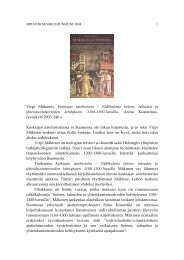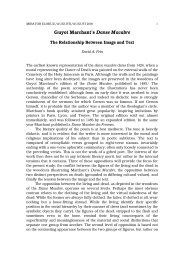Sigurðar saga fóts (The Saga of Sigurðr Foot)
Sigurðar saga fóts (The Saga of Sigurðr Foot)
Sigurðar saga fóts (The Saga of Sigurðr Foot)
Create successful ePaper yourself
Turn your PDF publications into a flip-book with our unique Google optimized e-Paper software.
MIRATOR 11:1/2010 66surely means ‘forwards’. 40 And it is hard to guess quite what is meant by ábak aftr—á bak basically means ‘backwards’; the rare collocation bak aftr canmean the same, but we should perhaps understand ‘backwards again’. 41 Is<strong>Sigurðr</strong> envisaged to be doing a backflip, or turning to face the otherdirection, or something else? <strong>The</strong> translation we <strong>of</strong>fer below—probably withless ambiguity than it deserves—says that he “was so quick and nimblefootedthat he neither leapt up more slowly nor lower into the air, landingbackwards on only one foot, than the most valiant people on both feetforwards”. Whatever the correct understanding, however, the image isdistinctive, and, given its prominence, suspiciously irrelevant to the action <strong>of</strong>the <strong>saga</strong>—the latter point emphasised by the omission <strong>of</strong> the explanation,albeit not the epithet, from both the medieval rímur and the Faroese ballads.It seems likely to have been inspired by another text, therefore. Kalinkesuggested the portrait <strong>of</strong> Gunnarr Hámundarson in chapter 19 <strong>of</strong> Njáls <strong>saga</strong>as the source. 42 Including in square brackets a relevant reading from MS Ofrom Einar Ól. Sveinsson’s textual apparatus: “hann hljóp meir en hæð sína[í l<strong>of</strong>t upp] með llum herklæðum, ok eigi skemmra aptr en fram fyrir sik”(“he jumped higher than his own height [into the air], in all his wargear, andno less distance backwards than forwards”). 43 Kirjalax <strong>saga</strong> also borrowedthis phrase from Njáls <strong>saga</strong>, saying <strong>of</strong> the eponymous hero that “hann hljóptólf álna áfram ok eigi skemra á bak aftr” (“he jumped twelve ells forward,and no less distance backwards”), but the phrasing in <strong>Sigurðar</strong> <strong>saga</strong> seems tobe closer to Njáls <strong>saga</strong>. 44 Unfortunately, the line in Njáls <strong>saga</strong> does not much40 Johan Fritzner, Ordbog over det gamle norske sprog, 4 vols, Den norske forlagsforening: Kristiania;Universitetsforlaget: Oslo, 1886–1972, accessed from, s.v. framlangt; Geir T. Zoëga, AConcise Dictionary <strong>of</strong> Old Icelandic, Oxford: Clarendon Press, 1910, accessed from; Richard Cleasby and Gudbrand Vigfusson, An Icelandic-EnglishDictionary, 2nd edn William A. Craigie, Oxford: Oxford University Press, 1957; cf. the Dictionary <strong>of</strong> OldNorse Prose citations at , s.v. framlangr.41 Dictionary <strong>of</strong> Old Norse Prose/Ordbog over det norrøne prosasprog, [ArnamagnæanCommission/Arnamagnæanske kommission], Copenhagen, 1983–, accessed from, s.v. bak.42 Kalinke 1990, 193 n. 43.43 Brennu-Njáls <strong>saga</strong>, Einar Ól. Sveinsson ed. (Íslenzk fornrit 12), Hið íslenzka fornritafélag: Reykjavík1954, 53; for one <strong>of</strong> the many translations see ‘Njal’s <strong>Saga</strong>’, Robert Cook trans., in <strong>The</strong> Complete <strong>Saga</strong>s<strong>of</strong> Icelanders, Viðar Hreinsson et al. (eds), 5 vols, Leifur Eiríksson Publishing: Reykjavík, 1997, iii 1–220.44 Normalised from Kirialax <strong>saga</strong>, Kr. Kålund ed. (Samfund til udgivelse af gammel nordisk litteratur43), Møller: Copenhagen 1917, 14 (linked with Njáls <strong>saga</strong> in n. 1). For the connection with Njáls <strong>saga</strong>,cf. Robert Cook, ‘Kirialax <strong>saga</strong>: A Bookish Romance’, in Régis Boyer ed. Les <strong>Saga</strong>s de Chevaliers(Riddarasögur): Actes de la V e Conférence Internationale sur les <strong>Saga</strong>s présentés par Régis Boyer(Toulon. Juillet 1982) (Série civilisations 10), Presses de l’Université Paris-Sorbonne: Toulon 1985, 303–326, at 307). <strong>The</strong> <strong>saga</strong> has been translated by Alenka Divjak, Studies in the Traditions <strong>of</strong> Kirialax <strong>saga</strong>,Institut Novie revije, zavod za humanistiko: Ljubljana, 2009, 297–352.


